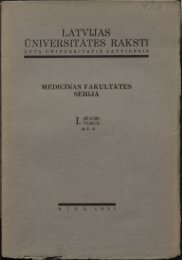ornamental sign language in the first order tracery belts - DSpace
ornamental sign language in the first order tracery belts - DSpace
ornamental sign language in the first order tracery belts - DSpace
Create successful ePaper yourself
Turn your PDF publications into a flip-book with our unique Google optimized e-Paper software.
Tenisons, M; Zeps, D. Ornamental Sign Language In The First Order Tracery Belts<br />
colors. Fourth, <strong>sign</strong>s <strong>in</strong> <strong>ornamental</strong> patters are <strong>in</strong>separable, i.e., <strong>sign</strong> transforms to o<strong>the</strong>r <strong>sign</strong>,<br />
<strong>sign</strong>s overlapp<strong>in</strong>g form <strong>sign</strong>s, and so on.<br />
The <strong>in</strong>terchange of colors <strong>in</strong> <strong>ornamental</strong> <strong>tracery</strong> of <strong>belts</strong> says that belt is readable <strong>in</strong> both<br />
ways equivalently, leav<strong>in</strong>g space for some aes<strong>the</strong>tic or artistic difference, with reference to<br />
human psyche. But <strong>the</strong>re is a way to read belt <strong>in</strong> both ways simultaneously, namely, when we<br />
see as if a belt <strong>in</strong> both ways. Then we may start to see belt as if b<strong>order</strong> between two colors,<br />
namely, we do not see „red on white” or „white on red” but <strong>the</strong> <strong>sign</strong> as a b<strong>order</strong> between both<br />
colors. After all that is what we are after: belt is <strong>the</strong> union of two elements, mascul<strong>in</strong>e and<br />
fem<strong>in</strong><strong>in</strong>e. In Latvian tradition this says that belt is <strong>the</strong> <strong>sign</strong> of Māra, „Māras zīme”. Christian<br />
tradition may say „<strong>sign</strong> of Christ”.<br />
Modris Tenisons as an artist uses ra<strong>the</strong>r a different way of expression, say<strong>in</strong>g, what we<br />
encounter as an aes<strong>the</strong>tics <strong>in</strong> <strong>the</strong> belt of Nica we must attribute to what <strong>the</strong> belt of Nica<br />
teaches us [4]. Thus we must say “The belt of Nica teaches us.” “The belt of Nica teaches us<br />
– In all should prevail simplicity. The belt of Nica teaches us – Noth<strong>in</strong>g excessive. ... Colors<br />
should be <strong>in</strong> equilibrium. ... Belt should be read between colors ... And so on."<br />
What concerns a partial equivalence of sides of belt, left and right sides <strong>in</strong> belt are equivalent<br />
<strong>in</strong> sense <strong>the</strong>y are readable <strong>in</strong> both ways, but right side rema<strong>in</strong>s prevalent over left side as right<br />
side (hand) is prevalent over left side (hand) <strong>in</strong> <strong>the</strong> human nature sett<strong>in</strong>gs: we discern right<br />
and left side as hom<strong>in</strong>es sapientes, but nature above us might have some <strong>in</strong>difference aga<strong>in</strong>st<br />
this dist<strong>in</strong>ction. This same message we see <strong>in</strong> ma<strong>the</strong>matics and physics. Lorentz transforms<br />
and right and left glove non-<strong>in</strong>terchangeability are guided by <strong>the</strong> same <strong>sign</strong>ature of<br />
quaternion [5]. Double cover of by don’t care of prevalence of right over left,<br />
but makes space for such prevalence. What we have <strong>in</strong> case of <strong>belts</strong> is two dimension case <strong>in</strong><br />
mostly convenient three dimensional case. It is nice to see that 2-dimensional case leaves<br />
over <strong>the</strong>se characteristic two po<strong>in</strong>ts „left” and „right” of unit circle <strong>in</strong> complex plane that<br />
would be actual for three-dimensional and higher cases. That we see <strong>in</strong> <strong>ornamental</strong> <strong>belts</strong><br />
<strong>in</strong>carnated <strong>in</strong> <strong>the</strong> pr<strong>in</strong>ciple of partial equivalence of sides of belt.<br />
Pict.11. Piece of <strong>ornamental</strong> <strong>tracery</strong> got from one seed of chaos.<br />
13




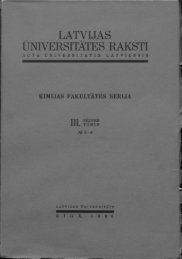
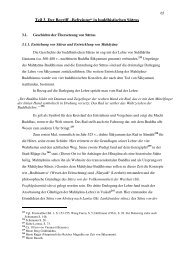
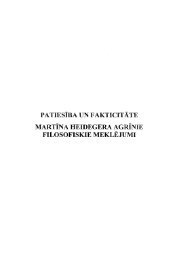
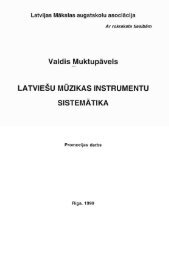
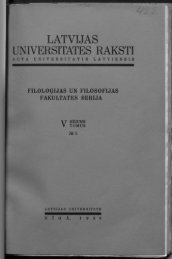
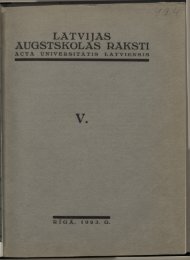




![LATVIJAS] - DSpace](https://img.yumpu.com/11778577/1/190x249/latvijas-dspace.jpg?quality=85)
